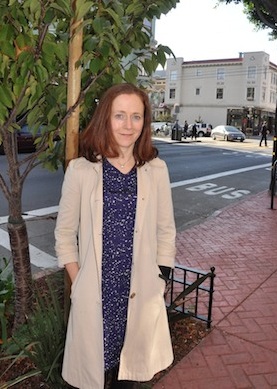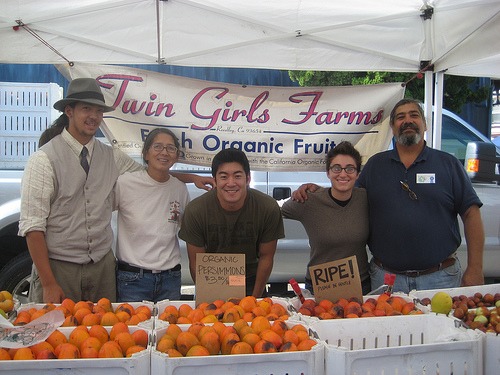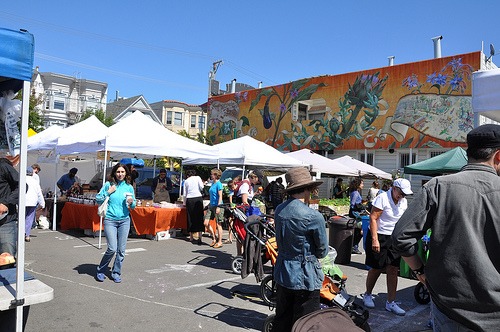I stroll down the aisle and sniff the basil carried on the air from the next stand over.
The sun is warm on my head, and there are children running about at my feet. They are not mine, but I know them all. The person shopping ahead of me for cippolini onions is a neighbor I haven’t seen in months. In five minutes, we’ve caught up on everything going on in both our lives. Shoppers swirl around us, a vendor offers us a slice of melon, and that smell of basil mixes with a strong scent of huevos on an open-air grill.
I love this place. I ask you, who wouldn’t want a neighborhood farmers’ market?
As it happens, quite a number of people. That’s what the founders of the Noe Valley Farmers’ Market (NVFM) discovered when they set about establishing their market in 2003.
The market was founded in response to the closing of the Real Food organic grocery on 24th Street in Noe Valley, San Francisco. A group of locals held meetings to decide what response the neighborhood could make to the sudden lack of organic fruits and vegetables, and the NVFM was born. The Real Food closed on Labor Day, and the NVFM opened a scant three months later.
 How did they do it?
How did they do it?
I sat down with Leslie Crawford (left), one of the original masterminds behind the market, to find out exactly how she and a handful of visionary neighbors pulled together what is now a local fixture.
Crawford, who is still deeply entangled in running it, overcame all manner of local obstacles—including a vocal contingent of naysayers—to build the market from scratch.
“It’s funny how little we knew,” she muses, “but we just sailed on with it anyway.”
Step One: Get your peas lined up In their pod
“When we started, I thought ‘Everybody’s going to love this idea!’" says Crawford. “I was shocked to find out I was wrong.”
Local merchants worried about parking and competing products being offered at lower prices, and neighbors worried about early morning noise, foot traffic, and the possibility of vermin showing up to snack on the mess the market would leave behind.
So do your homework before you begin. Have the answers to the following questions at your fingertips before you meet with neighborhood organizations and representatives:
- Consider whether there are other established options in the neighborhood already. Is the proposed market meeting a real need?
- How big do you want this to be? Provide a map of where you want your market, know your square footage, and have some sense of how many vendors you can accommodate.
- Is the property you have in mind for a market private land or public land? The rules differ according to where you want to pitch your tent. The NVFM is on private land, which, says Crawford, threw the city for a loop because most farmers’ markets operate on public or city-owned property.
And one more thing before you even really get started: The swift establishment of the NVFM notwithstanding, you should expect at least a year’s wait between starting this process and opening your market.

Credit: Nissa Anklesaria
Step Two: Talk to people who have already done it
Go online and see what resources are available to would-be farmers’ market creators, starting, of course, with this article.
Despite the current popularity of farmers’ markets, most cities don’t have a how-to organization to help markets get started. Start with your local department of agriculture or department of health, then hit the streets. Talk to the organizers and managers of other farmers’ markets in your area. They’ve already solved many of the same problems you are going to run into, so pick their brains and learn how to do it right. Find someone who has been through the process and, says Crawford, “Make that person your best friend.”
At this point you might want to consider handing the whole project over to an established farmers’ market management company. For instance, Pacific Coast runs several of the smaller markets in San Francisco. They already have the infrastructure and know what permits are needed.
The NVFM is an anomaly in that it is a non-profit organization run almost entirely by volunteers. In any case, it is a lot of work to start a market and keep it running. Be prepared for that.

Credit: Steve Rhodes
If you decide to engage a management company, stop here, and find one in your area. But if you want to continue on the Do It Yourself plan, read on…
Step Three: Get permits
Without a permit, you can’t do a darned thing.
But which permits? And where do you get them?
Start with your local department of health, and your city/county/state department of agriculture—just look up the number, call them, and tell them what you want to do. Hopefully, you'll talk to someone who wants to help you through the local process. Each state has its own rules around farmers’ markets; in California, for instance, you can “certify” your market, meaning that you agree to follow certain guidelines.
There are also independent agencies that provide guidelines for farmers’ market operations. Learn which are required and go from there.
Remember that you’ll also need fire permits if you will be selling prepared food, and that it is a good idea to notify the local police that you will be in operation. It’s always nice to have the law on your side.

Credit: Adam J. Kane
Step Four: Find farmers
No need to reinvent the wheel here either.
Go to existing markets and ask the vendors there if they would be interested in selling at your market.
Keep an eye on your balance of products—too much lettuce and not enough apples is just as bad as not enough lettuce and too many apples.
And be sure to treat the farmers in a businesslike fashion. You’re asking them to gamble on your new market, and they’re asking you to rely on them to be there consistently. Have documentation for them to sign that outlines your responsibilities and their obligations as contractors. (Need examples? Feel free to contact the NVFM at info (at) noevalleyfarmersmarket.com.)

Credit: Nissa Anklesaria
Step Five: Raise money
It is likely going to cost more than you think. You are essentially starting a small business when you are starting a farmers’ market, and you need to be prepared to fund it. Along with permits (for which of course the city charges money), you need to budget for liability insurance, the cost of the land lease, and just the cost of doing business (bank fees, a P.O. box, accounting, taxes, etc.).
Like many a start-up, the NVFM borrowed money from its founders in order to get off the ground. They were already mentally and physically and emotionally invested; the leap to becoming financially invested was not a huge one.
“Once the market had made some money,” says Crawford, “we paid ourselves back.”
If you haven’t got deep pockets, consider applying for a micro-loan, applying for a grant (the Department of Agriculture is offering $10 million in farmers' market grants in 2011-12!), or holding a community-based funding drive.
 The NVFM charges its vendors a modest weekly stall fee that covers market costs: the rent on the parking lot, equipment, insurance, garbage pick-up, onsite management, and other expenses.
The NVFM charges its vendors a modest weekly stall fee that covers market costs: the rent on the parking lot, equipment, insurance, garbage pick-up, onsite management, and other expenses.
Any money left over at the end of the year is disbursed to worthy causes. Past recipients of this largesse include Pie Ranch, a teaching farm in Pescadero. Crawford estimates that market expenses run into tens of thousands of dollars per year, and that breaking even is the goal.
“If you’re doing this for the profit,” she warns, “think again.”
Community Happens; or, What is the Role of a Farmers’ Market?
One of the joys of having a neighborhood market is that it can become the equivalent of the village green. Many American cities lack a casual, consistent gathering place; a farmer’s market can fill that need.
It can also be a platform for education on farm-related topics like the importance of eating locally grown and seasonal products, going green, buying organic, participating in composting, and general overall health.
“I didn’t know how patient we would have to be” when it came to building a community, Crawford notes. It takes time and a lot of hard work to create a loyal following and steady customers, but after six years and plenty of ups and downs, she says it’s satisfying, week after week, to see the market rise from the blacktop again to nourish the neighborhood.

Credit: Lisa Paul, Left Coast Cowboys
Want to read more about the Noe Valley Farmer's Market and its role in building a shareable neighborhood? Check out this piece on how to organize a nature group for city kids.









